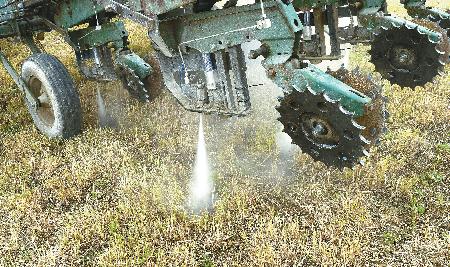High-Pressure Waterjets Slice Through Crop Residue

Forget about residue problems with no-till planting. Now planters and drills can be equipped with waterjets instead of residue cutting coulters. At 60,000 psi, the A-Cubed waterjet system cuts through crop residue and into the soil, using only 20 gal. of water or liquid fertilizer per acre.
"We've proven we can cut through heavy residue and trash at any speed a planter or drill can travel," says Jeff Martel, A-Cubed. "We can also vary the penetration depth into the soil while cutting not only residue, but root crowns and other biomass."
Success with initial applications doesn?t mean the system will be available just yet. A-Cubed, a division of I-Cubed Industry Innovators, is continuing research on system components and on the system?s impact on the planted crop.
"Our goal is to reduce the orifice the fluid travels through to the diameter of a human hair, 0.006 in.," says Martel. "This will reduce horsepower needed and produce a fluid stream traveling at Mach 3 or 2,600 mph."
Just as important is the research Martel and associates are doing on the waterjet soil interaction. In 2017 corn planted with the waterjet system produced a 20 percent higher yield by weight than conventionally planted corn in side-by-side trials. They also saw earlier emergence of both corn and soybeans. A-Cubed is trying to identify the reasons why.
Early signs indicate heat transfer may be part of the answer. ?The fluid is at 140 degrees when it hits the soil," says Martel. "It adds about 70 to 80 degrees to the ambient temperature of the soil."
Martel previously worked for the company that manufactures the pump. The company had been approached by the South Australia No-Till Farmers Association for a way to use water pressure to cut through crop residue. When progress lagged at that company, Martel took it to Ontario-based I-Cubed.
Research with the system in 2018 will continue to compare water-fed jets versus fertilizer solutions. It will also compare horsepower needed for waterjet residue cutting versus conventional mechanical residue management.
"We are trying to get the horsepower needed as low as possible," says Martel. "We are also looking at different soil types and biomass."
Martel is reaching out to agronomists and growers interested in working with the system. Work is also ongoing in China and Australia. The end goal is a retrofit kit for existing planters and seeders, as well as systems for new equipment.
